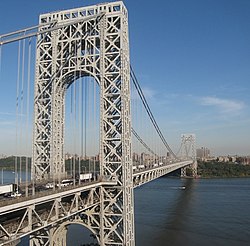Suspension bridge
A suspension bridge is a type of bridge that has been made since ancient times as early as 100 AD. Some simple suspension bridges, for use by pedestrians and livestock, are still constructed, based upon the ancient Inca rope bridge.
Suspended from two high locations over a river or canyon, simple suspension bridges follow a shallow downward arc and are not suited for modern roads and railroads.
The design of the modern suspended-deck suspension bridge was developed in the early 19th century. It can cross a longer span than other kinds of bridges.
The Akashi Kaikyō Bridge is the world's longest suspension bridge.[1]
Suspension Bridge Media
The double-decked George Washington Bridge, connecting New York City to Bergen County, New Jersey, is the world's busiest suspension bridge, carrying 106 million vehicles annually.
The Manhattan Bridge, connecting Manhattan and Brooklyn in New York City, opened in 1909 and is considered to be the forerunner of modern suspension bridges; its design served as the model for many of the long-span suspension bridges around the world.
An early plan for the chain bridge over the Menai Strait near Bangor, Wales, completed in 1826
Squibb Park Bridge, Brooklyn, built 2013
Eyebar chain cables of Clifton Suspension Bridge
The Yichang Bridge, a plate deck suspension bridge, over the Yangtze River in China
A former steam pipeline suspension bridge on the Lake Näsijärvi in Tampere, Finland, in 1979
References
- ↑ Cooper, James D. "World's Longest Suspension Bridge Opens in Japan," Public Roads (US), July/August 1998, Vol. 62, No. 1; retrieved 2012-3-24.
Other websites
| Wikimedia Commons has media related to Lua error in Module:Commons_link at line 62: attempt to index field 'wikibase' (a nil value).. |
- Sructurae, Suspension Bridges
- Bridgemeister, Suspension Bridges







